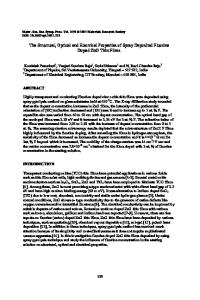Effect of thermal evolution of point defects on the electrical properties of nitrogen-implanted ZnO thin films
- PDF / 2,902,242 Bytes
- 6 Pages / 595.276 x 790.866 pts Page_size
- 27 Downloads / 355 Views
Effect of thermal evolution of point defects on the electrical properties of nitrogen‑implanted ZnO thin films Wanjun Li1 · Chunni Wang1 · Jianwen Ma1 · Hong Zhang1 · Yuanqiang Xiong1 · Honglin Li1 · Lijuan Ye1 · Haibo Ruan2 · Guoping Qin1 · Liang Fang3 · Chunyang Kong1 Received: 20 November 2019 / Accepted: 21 January 2020 © Springer Science+Business Media, LLC, part of Springer Nature 2020
Abstract Raman backscattering spectroscopy and X-ray photoelectron spectroscopy have been applied to study thermal evolution of point defects as a function of post-annealing temperature in nitrogen-implanted ZnO thin films (ZnO:N). Z ni-related donor defects (e.g., Zni-NO complexes or Zni clusters) are prone to dissociation to form a freely moving isolated Zni defect by postannealing process, which is extremely advantageous for achieving a p-type transition of the ZnO:N film. However, lots of Ni atoms induced by ion implantation could migrate to the near-surface of the films to form NC/NH/NO species with increasing post-annealing temperature, resulting in a lower concentration of N O acceptor defects in ZnO:N films. In addition, although post-annealing at higher temperatures can form more No acceptor defects, the newly generated (N2)O double donor defects have a severe self-compensating effect. Consequently, the concentration of both the Zni-related donors and effective acceptors gradually decreases at elevated post-annealing temperatures, which is the reason why all ZnO:N films present n-type conductivity and do not convert to p-type conductivity.
1 Introduction Zinc oxide (ZnO) is a direct oxide semiconductor with a wide bandgap of 3.37 eV at room temperature and a relatively high exciton binding energy of 60 meV as compared to GaN [1]. These excellent characteristics promise a great potential for a wide range of applications, including ultraviolet (UV) lasers, light-emitting diodes, UV photodetectors, photocatalysts, gas sensors, flat panel displays, and fieldeffect transistors and so on [1, 2]. To achieve the application of ZnO in short-wavelength bipolar devices, high-quality p-type ZnO materials are indispensable. In the past decades, researchers from all over the world have made great efforts * Wanjun Li [email protected]; [email protected] 1
Chongqing Key Laboratory of Photo‑Electric Functional Materials, College of Physics and Electronic Engineering, Chongqing Normal University, Chongqing 401331, People’s Republic of China
2
Research Center for Materials Interdisciplinary Sciences, Chongqing University of Arts and Sciences, Chongqing 402160, People’s Republic of China
3
College of Physics, Chongqing University, Shapingba, Chongqing 401331, People’s Republic of China
on the research of p-type doping; the p-type ZnO doped by various acceptor elements was successfully realized by continuous improvement of various doping methods and optimized preparation technologies, and even ZnO-based homogeneous p–n junction bipolar devices have been obtained [3–5]. Unfortunately, the electrical parameters of th
Data Loading...










